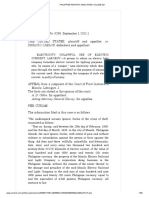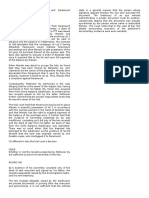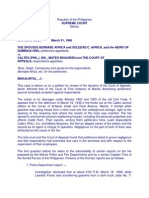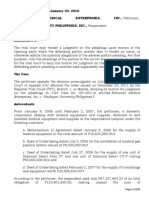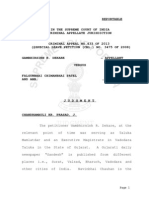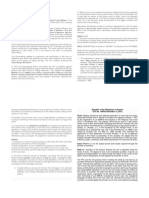0 ratings0% found this document useful (0 votes)
25 viewsA. D. Gibbs For Appellant. Acting Attorney-General Harvey For Appellee
A. D. Gibbs For Appellant. Acting Attorney-General Harvey For Appellee
Uploaded by
Robehgene Atud-Javinar- Ignacio Carlos was accused of stealing 2,273 kilowatt hours of electricity valued at 909.20 pesos from the Manila Electric Railroad and Light Company over 13 months.
- Carlos was found guilty at trial and sentenced to 1 year and 8 months imprisonment along with fines. He appealed the conviction.
- On appeal, the court upheld the conviction, finding that evidence from two meters showed Carlos had stolen over 10 times the electricity registered, and a "jumper" device was found that could bypass the meter. The court ruled this was sufficient evidence of Carlos' guilt of theft.
Copyright:
© All Rights Reserved
Available Formats
Download as DOCX, PDF, TXT or read online from Scribd
A. D. Gibbs For Appellant. Acting Attorney-General Harvey For Appellee
A. D. Gibbs For Appellant. Acting Attorney-General Harvey For Appellee
Uploaded by
Robehgene Atud-Javinar0 ratings0% found this document useful (0 votes)
25 views5 pages- Ignacio Carlos was accused of stealing 2,273 kilowatt hours of electricity valued at 909.20 pesos from the Manila Electric Railroad and Light Company over 13 months.
- Carlos was found guilty at trial and sentenced to 1 year and 8 months imprisonment along with fines. He appealed the conviction.
- On appeal, the court upheld the conviction, finding that evidence from two meters showed Carlos had stolen over 10 times the electricity registered, and a "jumper" device was found that could bypass the meter. The court ruled this was sufficient evidence of Carlos' guilt of theft.
Original Description:
case
Original Title
6. US v. Carlos_Case
Copyright
© © All Rights Reserved
Available Formats
DOCX, PDF, TXT or read online from Scribd
Share this document
Did you find this document useful?
Is this content inappropriate?
- Ignacio Carlos was accused of stealing 2,273 kilowatt hours of electricity valued at 909.20 pesos from the Manila Electric Railroad and Light Company over 13 months.
- Carlos was found guilty at trial and sentenced to 1 year and 8 months imprisonment along with fines. He appealed the conviction.
- On appeal, the court upheld the conviction, finding that evidence from two meters showed Carlos had stolen over 10 times the electricity registered, and a "jumper" device was found that could bypass the meter. The court ruled this was sufficient evidence of Carlos' guilt of theft.
Copyright:
© All Rights Reserved
Available Formats
Download as DOCX, PDF, TXT or read online from Scribd
Download as docx, pdf, or txt
0 ratings0% found this document useful (0 votes)
25 views5 pagesA. D. Gibbs For Appellant. Acting Attorney-General Harvey For Appellee
A. D. Gibbs For Appellant. Acting Attorney-General Harvey For Appellee
Uploaded by
Robehgene Atud-Javinar- Ignacio Carlos was accused of stealing 2,273 kilowatt hours of electricity valued at 909.20 pesos from the Manila Electric Railroad and Light Company over 13 months.
- Carlos was found guilty at trial and sentenced to 1 year and 8 months imprisonment along with fines. He appealed the conviction.
- On appeal, the court upheld the conviction, finding that evidence from two meters showed Carlos had stolen over 10 times the electricity registered, and a "jumper" device was found that could bypass the meter. The court ruled this was sufficient evidence of Carlos' guilt of theft.
Copyright:
© All Rights Reserved
Available Formats
Download as DOCX, PDF, TXT or read online from Scribd
Download as docx, pdf, or txt
You are on page 1of 5
G.R. No.
6295 September 1, 1911
THE UNITED STATES, plaintiff-appellee,
vs.
IGNACIO CARLOS, defendant-appellant.
A. D. Gibbs for appellant.
Acting Attorney-General Harvey for appellee.
PER CURIAM:
The information filed in this case is as follows:
The undersigned accuses Ignacio Carlos of the crime of theft, committed as follows:
That on, during, and between the 13th day of February, 1909, and the 3d day of March, 1910, in
the city of Manila, Philippine Islands, the said Ignacio Carlos, with intent of gain and without
violence or intimidation against the person or force against the thing, did then and there, willfully,
unlawfully, and feloniously, take, steal , and carry away two thousand two hundred and seventy-
three (2,273) kilowatts of electric current, of the value of nine hundred and nine (909) pesos and
twenty (20) cents Philippine currency, the property of the Manila Electric Railroad and Light
Company, a corporation doing business in the Philippine Islands, without the consent of the owner
thereof; to the damage and prejudice of the said Manila Electric Railroad and Light Company in the
said sum of nine hundred and nine (909) pesos and twenty (20) cents Philippine currency, equal to
and equivalent of 4,546 pesetas Philippine currency. All contrary to law.
(Sgd.) L. M. SOUTWORTH,
Prosecuting Attorney.
Subscribed and sworn to before me this 4th day of March, 1910, in the city of Manila, Philippine
Islands, by L. M. Southworth, prosecuting attorney for the city of Manila.
(Sgd.) CHARLES S. LOBINGIER,
Judge, First Instance.
A preliminary investigation has heretofore been conducted in this case, under my direction, having
examined the witness under oath, in accordance with the provisions of section 39 of Act No. 183 of
the Philippine Commission, as amended by section 2 of Act No. 612 of the Philippine Commission.
(Sgd) L. M. SOUTHWORTH,
Prosecuting Attorney.
Subscribed and sworn to before me this 4th day of March, 1910, in the city of Manila, Philippine
Islands, by L. M. Southworth, prosecuting attorney for the city of Manila.
(Sgd.) CHARLES LOBINGIER,
Judge, First Instance.
A warrant for the arrest of the defendant was issued by the Honorable J. C. Jenkins on the 4th of March
and placed in the hands of the sheriff. The sheriff's return shows that the defendant gave bond for his
appearance. On the 14th of the same month counsel for the defendant demurrer to the complaint on the
following grounds:
1 That the court has no jurisdiction over the person of the accused nor of the offense charged
because the accused has not been accorded a preliminary investigation or examination as required
by law and no court, magistrate, or other competent authority has determined from a sworn
complaint or evidence adduced that there is probable cause to believe that a crime has been
committed, or that this defendant has committed any crime.
2 That the facts charged do not constitute a public offense.
The demurrer was overruled on the same day and the defendant having refused to plead, a plea of not
guilty was entered by direction of the court for him and the trial proceeded.
After due consideration of all the proofs presented and the arguments of counsel the trial court found the
defendant guilty of the crime charged and sentenced him to one year eight months and twenty-one
days' presidio correccional, to indemnify the offended party, The Manila Electric Railroad and Light
Company, in the sum of P865.26, to the corresponding subsidiary imprisonment in case of insolvency and
to the payment of the costs. From this judgment the defendant appealed and makes the following
assignments of error:
I.
The court erred in overruling the objection of the accused to the jurisdiction of the court, because
he was not given a preliminary investigation as required by law, and in overruling his demurrer for
the same reason.
II.
The court erred in declaring the accused to be guilty, in view of the evidence submitted.
III.
The court erred in declaring that electrical energy may be stolen.
IV.
The court erred in not declaring that the plaintiff consented to the taking of the current.
V.
The court erred in finding the accused guilty of more than one offense.
VI.
The court erred in condemning the accused to pay P865.26 to the electric company as damages.
Exactly the same question as that raised in the first assignment of error, was after a through examination
and due consideration, decided adversely to appellant's contention in the case of U. S. vs. Grant and
Kennedy (18 Phil. Rep., 122). No sufficient reason is presented why we should not follow the doctrine
enunciated in that case.
The question raised in the second assignment of error is purely one fact. Upon this point the trial court
said:
For considerably more than a year previous to the filing of this complaint the accused had been a
consumer of electricity furnished by the Manila Electric Railroad and Light Company for a building
containing the residence of the accused and three other residences, and which was equipped,
according to the defendant's testimony, with thirty electric lights. On March 15, 1909, the
representatives of the company, believing that more light was being used than their meter showed,
installed an additional meter (Exhibit A) on a pole outside of defendant's house, and both it and the
meter (Exhibit B) which had been previously installed in the house were read on said date. Exhibit
A read 218 kilowatt hours; Exhibit B, 745 kilowatt hours. On March 3, 1910 each was read again,
Exhibit A showing 2,718 kilowatt hours and Exhibit B, 968. It is undisputed that the current which
supplied the house passed through both meters and the city electrician testifies that each meter
was tested on the date of the last reading and was "in good condition." The result of this registration
therefore is that while the outsider meter (Exhibit A) showed a consumption in defendant's building
of 2,500 kilowatt hours of electricity, this inside meter (Exhibit B) showed but 223 kilowatt hours.
In other words the actual consumption, according to the outside meter, was more than ten times as
great as that registered by the one inside. Obviously this difference could not be due to normal
causes, for while the electrician called by the defense (Lanusa) testifies to the possibility of a
difference between two such meters, he places the extreme limit of such difference between them 5
per cent. Here, as we have seen, the difference is more than 900 per cent. Besides, according to the
defendant's electrician, the outside meter should normally run faster, while according to the test
made in this case the inside meter (Exhibit B) ran the faster. The city electrician also testifies that
the electric current could have been deflected from the inside meter by placing thereon a device
known as a "jumper" connecting the two outside wires, and there is other testimony that there were
marks on the insulation of the meter Exhibit B which showed the use of such a device. There is a
further evidence that the consumption of 223 kilowatt hours, registered by the inside meter would
not be a reasonable amount for the number of lights installed in defendant's building during the
period in question, and the accused fails to explain why he should have had thirty lights installed if
he needed but four or five.
On the strength of this showing a search warrant was issued for the examination of defendant's
premises and was duly served by a police officer (Hartpence). He was accompanied at the time by
three employees of the Manila Electric Railroad and Light Company, and he found there the
accused, his wife and son, and perhaps one or two others. There is a sharp conflict between the
several spectators on some points but on one there is no dispute. All agree that the "jumper"
(Exhibit C) was found in a drawer of a small cabinet in the room of defendant's house where the
meter was installed and not more than 20 feet therefrom. In the absence of a satisfactory
explanation this constituted possession on defendant's part, and such possession, under the Code
of Civil Procedure, section 334 (10), raises the presumption that the accused was the owner of a
device whose only use was to deflect the current from the meter.
Is there any other "satisfactory explanation" of the "jumper's" presence? The only one sought to be
offered is the statement by the son of the accused, a boy of twelve years, that he saw the "jumper"
placed there by the witness Porter, an employee of the Light Company. The boy is the only witness
who so testifies and Porter himself squarely denies it. We can not agree with counsel for the defense
that the boy's interest in the outcome of this case is less than that of the witness for the
prosecution. It seems to us that his natural desire to shield his father would far outweight any
interest such an employee like Porter would have and which, at most, would be merely pecuniary.
There is, however, one witness whom so far as appears, has no interest in the matter whatsoever.
This is officer Hartpence, who executed the search warrant. He testifies that after inspecting other
articles and places in the building as he and the other spectators, including the accused,
approached the cabinet in which the "jumper" was found, the officer's attention was called to the
defendant's appearance and the former noticed that the latter was becoming nervous. Where the
only two witnesses who are supposed to know anything of the matter thus contradict each other
this item of testimony by the officer is of more than ordinary significance; for if, as the accused
claims, the "jumper" was placed in the cabinet for the first time by Porter there would be no
occasion for any change of demeanor on the part of the accused. We do not think that the officer's
declination to wait until defendant should secure a notary public shows bias. The presence of such
an official was neither required nor authorized by law and the very efficacy of a search depends
upon its swiftness.
We must also agree with the prosecuting attorney that the attending circumstances do not
strengthen the story told by the boy; that the latter would have been likely to call out at the time he
saw the "jumper" being placed in the drawer, or at least directed his father's attention to it
immediately instead of waiting, as he says, until the latter was called by the officer. Finally, to
accept the boy's story we must believe that this company or its representatives deliberately
conspired not merely to lure the defendant into the commission of a crime but to fasten upon him a
crime which he did not commit and thus convict an innocent man by perjured evidence. This is a
much more serious charge than that contained in the complaint and should be supported by very
strong corroborating circumstances which we do not find here. We are, accordingly, unable to
consider as satisfactory defendant's explanation of the "jumper's" presence.
The only alternative is the conclusion that the "jumper" was placed there by the accused or by some
one acting for him and that it was the instrument by which the current was deflected from the
matter Exhibit B and the Light Company deprived of its lawful compensation.
After a careful examination of the entire record we are satisfied beyond peradventure of a doubt that the
proofs presented fully support the facts as set forth in the foregoing finding.
Counsel for the appellant insists that the only corporeal property can be the subject of the crime of
larceny, and in the support of this proposition cites several authorities for the purpose of showing that the
only subjects of larceny are tangible, movable, chattels, something which could be taken in possession and
carried away, and which had some, although trifling, intrinsic value, and also to show that electricity is an
unknown force and can not be a subject of larceny.
In the U. S. vs. Genato (15 Phi. Rep., 170) the defendant, the owner of the store situated at No. 154
Escolta, Manila, was using a contrivance known as a "jumper" on the electric meter installed by the Manila
Electric Railroad and the Light Company. As a result of the use of this "jumper" the meter, instead of
making one revolution in every four seconds, registered one in seventy-seven seconds, thereby reducing
the current approximately 95 per cent. Genato was charged in the municipal court with a violation of a
certain ordinance of the city of Manila, and was sentenced to pay a fine of P200. He appealed to the Court
of First Instance, was again tried and sentenced to pay the same fine. An appeal was taken from the
judgment of the Court of First Instance to the Supreme Court on the ground that the ordinance in question
was null and void. It is true that the only question directly presented was of the validity of the city
ordinance. The court, after holding that said ordinance was valid, said:
Even without them (ordinances), the right of ownership of electric current is secured by articles 517
and 518 of the Penal Code; the application of these articles in case of subtraction of gas, a fluid
used for lighting, and in some respects resembling electricity, is confirmed by the rule laid down in
the decisions of the supreme court of Spain January 20, 1887, and April 1, 1897, construing and
enforcing the provisions of articles 530 and 531 of the penal code of that country, articles identical
with articles 517 and 518 of the code in force in these Islands.
Article 517 of the Penal Code above referred to reads as follows:
The following are guilty of larceny:
(1) Those who with intent of gain and without violence or intimidation against the person, or force
against things, shall take another's personal property without the owner's consent.
And article 518 fixes the penalty for larceny in proportion to the value of the personal property stolen.
It is true that electricity is no longer, as formerly, regarded by electricians as a fluid, but its manifestation
and effects, like those of gas, may be seen and felt. The true test of what is a proper subject of larceny
seems to be not whether the subject is corporeal, but whether it is capable of appropriation by another
than the owner.
It is well-settled that illuminating gas may be the subject of larceny, even in the absence of a statute so
providing. (Decisions of supreme court of Spain, January 20, 1887, and April 1, 1897, supra; also
(England) Queen vs. Firth, L. R. 1 C. C., 172, 11 Cox C. C., 234; Queen vs. White, 3 C. & K., 363, 6 Cox C.
C., 213; Woods vs. People, 222 III., 293, 7 L. R. A., 520; Commonwealth vs. Shaw, 4 Allen (Mass), 308;
State vs. Wellman, 34 Minn., 221, N. W. Rep., 385, and 25 Cyc., p. 12, note 10.)
In the case of Commonwealth vs. Shaw, supra, the court, speaking through Chief Justice Bigelow, said:
There is nothing in the nature of gas used for illuminating purposes which renders it incapable of
being feloniously taken and carried away. It is a valuable article of merchandise, bought and sold
like other personal property, susceptible of being severed from a mass or larger quantity, and of
being transported from place to place. In the present case it appears that it was the property of the
Boston Gas Light Company; that it was in their possession by being confined in conduits and tubes
which belonged to them, and that the defendant severed a portion of that which was in the pipes of
the company by taking it into her house and there consuming it. All this being proved to have been
done by her secretly and with intent to deprive the company of their property and to appropriate it
to her own use, clearly constitutes the crime of larceny.
Electricity, the same as gas, is a valuable article of merchandise, bought and sold like other personal
property and is capable of appropriation by another. So no error was committed by the trial court in
holding that electricity is a subject of larceny.
It is urged in support of the fourth assignment of error that if it be true that the appellant did appropriate
to his own use the electricity as charged he can not be held guilty of larceny for any part of the electricity
thus appropriated, after the first month, for the reason that the complaining party, the Manila Electric
Road and Light Company, knew of this misappropriation and consented thereto.
The outside meter was installed on March 15, 1909, and read 218 kilowatt hours. On the same day the
inside meter was read and showed 745 kilowatt hours. Both meters were again read on March 3, 1910,
and the outside one showed 2,718 kilowatt hours while the one on the inside only showed 968, the
difference in consumption during this time being 2,277 kilowatt hours. The taking of this current
continued over a period of one year, less twelve days. Assuming that the company read both meters at the
end of each month; that it knew the defendant was misappropriating the current to that extent; and that t
continued to furnish the current, thereby giving the defendant an opportunity to continue the
misppropriation, still, we think, that the defendant is criminally responsible for the taking of the whole
amount, 2,277 kilowatt hours. The company had a contract with the defendant to furnish him with current
for lighting purposes. It could not stop the misappropriation without cutting off the current entirely. It
could not reduce the current so as to just furnish sufficient for the lighting of two, three, or five lights, as
claimed by the defendant that he used during the most of this time, but the current must always be
sufficiently strong to furnish current for the thirty lights, at any time the defendant desired to use them.
There is no pretense that the accused was solicited by the company or any one else to commit the acts
charged. At most there was a mere passive submission on the part of the company that the current should
be taken and no indication that it wished it to be taken, and no knowledge by the defendant that the
company wished him to take the current, and no mutual understanding between the company and the
defendant, and no measures of inducement of any kind were employed by the company for the purpose of
leading the defendant into temptation, and no preconcert whatever between him and company. The
original design to misappropriate this current was formed by the defendant absolutely independent of any
acts on the part of the company or its agents. It is true, no doubt, as a general proposition, that larceny is
not committed when the property is taken with the consent of its owner. It may be difficult in some
instances to determine whether certain acts constitute, in law, such "consent." But under the facts in the
case at bar it is not difficult to reach a conclusion that the acts performed by the plaintiff company did not
constitute a consent on its part the defendant take its property. We have been unable to find a well
considered case holding contrary opinion under similar facts, but, there are numerous cases holding that
such acts do not constitute such consent as would relieve the taker of criminal responsibility. The fourth
assignment of error is, therefore, not well founded.
It is also contended that since the "jumper" was not used continuously, the defendant committed not a
single offense but a series of offenses. It is, no doubt, true that the defendant did not allow the "jumper" to
remain in place continuously for any number of days as the company inspected monthly the inside meter.
So the "jumper" was put on and taken off at least monthly, if not daily, in order to avoid detection, and
while the "jumper" was off the defendant was not misappropriating the current. The complaint alleged that
the defendant did on, during, and between the 13th day of February, 1909, and the 3d of March, 1910.
willfully, unlawfully, and feloniously take, steal, and carry away 2,277 kilowatts of electric current of the
value of P909. No demurrer was presented against this complaint on the ground that more than one crime
was charged. The Government had no opportunity to amend or correct this error, if error at all. In the case
of U. S. vs. Macaspac (12 Phil. Rep., 26), the defendant received from one Joquina Punu the sum of
P31.50, with the request to deliver it to Marcelina Dy-Oco. The defendant called upon Marcelina, but
instead of delivering the said amount she asked Marcelina for P30 in the name of Joaquina who had in no
way authorized her to do so. Marcelina gave her P30, believing that Joaquina had sent for it. Counsel for
the defendant insisted that the complaint charged his client with two different crimes of estafa in violation
of section 11 of General Orders, No. 58. In disposing of this question this court said:
The said defect constitutes one of the dilatory pleas indicated by section 21, and the accused ought
to have raised the point before the trial began. Had this been done, the complaint might have been
amended in time, because it is merely a defect of form easily remedied. . . . Inasmuch as in the first
instance the accused did not make the corresponding dilatory plea to the irregularity of the
complaint, it must be understood that has waived such objection, and is not now entitled to raise
for the first time any question in reference thereto when submitting to this court her assignment of
errors. Apart from the fact that the defense does not pretend that any of the essential rights of the
accused have been injured, the allegation of the defect above alluded to, which in any case would
only affect form of the complaint, can not justify a reversal of the judgment appealed from,
according to the provisions of section 10 of General Orders, No. 58.
In the case at bar it is not pointed out wherein any of the essential rights of the defendant have been
prejudiced by reason of the fact that the complaint covered the entire period. If twelve distinct and separate
complaints had been filed against the defendant, one for each month, the sum total of the penalties
imposed might have been very much greater than that imposed by the court in this case. The covering of
the entire period by one charge has been beneficial, if anything, and not prejudicial to the rights of the
defendant. The prosecuting attorney elected to cover the entire period with one charge and the accused
having been convicted for this offense, he can not again be prosecuted for the stealing of the current at any
time within that period. Then, again, we are of the opinion that the charge was properly laid. The electricity
was stolen from the same person, in the same manner, and in the same place. It was substantially one
continuous act, although the "jumper" might have been removed and replaced daily or monthly. The
defendant was moved by one impulse to appropriate to his own use the current, and the means adopted by
him for the taking of the current were in the execution of a general fraudulent plan.
A person stole gas for the use of a manufactory by means of pipe, which drew off the gas from the
main without allowing it to pass through the meter. The gas from this pipe was burnt every day,
and turned off at night. The pipe was never closed at this junction with the main, and consequently
always remained full of gas. It was held, that if the pipe always remained full, there was, in fact, a
continuous taking of the gas and not a series of separate talkings. It was held also that even if the
pipe had not been kept full, the taking would have been continuous, as it was substantially all one
transaction. (Regina vs. Firth, L. R., 1 C. C., 172; 11 Cox C. C., 234. Cited on p. 758 of Wharton's
Criminal Law, vol. 1, 10th ed.)
The value of the electricity taken by the defendant was found by the trial court to be P865.26. This finding
is fully in accordance with the evidence presented. So no error was committed in sentencing the defendant
to indemnify the company in this amount, or to suffer the corresponding subsidiary imprisonment in case
of insolvency.
The judgment being strictly in accordance with the law and the merits of the case, same is hereby affirmed,
with costs against the appellant.
Arellano, C.J., Torres, Mapa and Carson, JJ.
You might also like
- Nevada Reports 1985 (101 Nev.) PDFDocument864 pagesNevada Reports 1985 (101 Nev.) PDFthadzigsNo ratings yet
- 60 Day NoticeDocument3 pages60 Day NoticejlurosNo ratings yet
- A. D. Gibbs For Appellant. Acting Attorney-General Harvey For AppelleeDocument7 pagesA. D. Gibbs For Appellant. Acting Attorney-General Harvey For AppelleeNikki Joanne Armecin LimNo ratings yet
- US vs. CarlosDocument30 pagesUS vs. CarlosRhei BarbaNo ratings yet
- Property Law 1-22Document38 pagesProperty Law 1-22Marione John SetoNo ratings yet
- Us v. CarlosDocument28 pagesUs v. Carloskaleidoscope worldNo ratings yet
- Supreme Court: A. D. Gibbs For Appellant. Acting Attorney-General Harvey For AppelleeDocument23 pagesSupreme Court: A. D. Gibbs For Appellant. Acting Attorney-General Harvey For AppelleeNufa AlyhaNo ratings yet
- Supreme Court: A. D. Gibbs For Appellant. Acting Attorney-General Harvey For AppelleeDocument25 pagesSupreme Court: A. D. Gibbs For Appellant. Acting Attorney-General Harvey For AppelleeCherry UrsuaNo ratings yet
- US V CarlosDocument51 pagesUS V CarlosMeg VillaricaNo ratings yet
- The United States vs. Ignacio CarlosDocument8 pagesThe United States vs. Ignacio CarlosJayzell Mae FloresNo ratings yet
- Property Full Cases (Public Dominion-Ownership)Document191 pagesProperty Full Cases (Public Dominion-Ownership)Aya BeltranNo ratings yet
- 18 U.S. v. Carlos PDFDocument52 pages18 U.S. v. Carlos PDFClarinda MerleNo ratings yet
- U.S. v. CarlosDocument59 pagesU.S. v. CarlosDana Mae TadeaNo ratings yet
- Evidence Case DigestDocument6 pagesEvidence Case DigestTrixie Jane NeriNo ratings yet
- Supreme Court: Bishop and O'Brien For Appellant. Attorney-General Wilfley For AppelleeDocument81 pagesSupreme Court: Bishop and O'Brien For Appellant. Attorney-General Wilfley For AppelleeAleph JirehNo ratings yet
- Cases - Property - 2 - MovablesDocument10 pagesCases - Property - 2 - MovableskgaviolaNo ratings yet
- 8) 21 Phil 543 - GR 6295 - US v. CarlosDocument32 pages8) 21 Phil 543 - GR 6295 - US v. CarlosLeopoldo, Jr. BlancoNo ratings yet
- 32 - GR - No. - L-3383 - Leonco Vs InquiDocument5 pages32 - GR - No. - L-3383 - Leonco Vs InquiAmnesia BandNo ratings yet
- Zapanta Vs PeopleDocument7 pagesZapanta Vs PeopleEricson Sarmiento Dela CruzNo ratings yet
- US v. CarlosDocument43 pagesUS v. CarlosVilpa VillabasNo ratings yet
- 01 Franco Vs People 20 Isigne Vs Abra Valley CollegesDocument5 pages01 Franco Vs People 20 Isigne Vs Abra Valley CollegesTootsie GuzmaNo ratings yet
- Case Digest 3Document36 pagesCase Digest 3Mellie MorcozoNo ratings yet
- Spouses Dulay v. PeopleDocument1 pageSpouses Dulay v. Peoplehello thereNo ratings yet
- Supreme Court: Bishop and O'Brien For Appellant. Attorney-General Wilfley For AppelleeDocument3 pagesSupreme Court: Bishop and O'Brien For Appellant. Attorney-General Wilfley For AppelleeMiamor NatividadNo ratings yet
- Hoefman Appeal DecisionDocument11 pagesHoefman Appeal DecisionCHAT NEWSNo ratings yet
- Africa VS Caltex (Phils), GR L-12986, March 31, 1966Document9 pagesAfrica VS Caltex (Phils), GR L-12986, March 31, 1966anj sppNo ratings yet
- Rules Review CaseDocument4 pagesRules Review CaseMegie TumbagahanNo ratings yet
- Adr Cases and Admin AgencyDocument8 pagesAdr Cases and Admin AgencyMaria Danice AngelaNo ratings yet
- Dionisio Esguerra Vs PeopleDocument3 pagesDionisio Esguerra Vs PeopleHenry LNo ratings yet
- Insular Gov't vs. FrankDocument2 pagesInsular Gov't vs. FrankMannor ModaNo ratings yet
- Batal DigestDocument4 pagesBatal DigestMilcah MagpantayNo ratings yet
- EMELITA SOLARTE, Complainant, vs. ATTY. TEOFILO F. PUGEDA, Respondent.Document3 pagesEMELITA SOLARTE, Complainant, vs. ATTY. TEOFILO F. PUGEDA, Respondent.Happy DirigeNo ratings yet
- Africa Vs CaltexDocument8 pagesAfrica Vs Caltexchibi_carolNo ratings yet
- Us Vs CarlosDocument59 pagesUs Vs CarlosanonNo ratings yet
- Clemente v. GalvanDocument4 pagesClemente v. GalvanJoseph Raymund BautistaNo ratings yet
- Bishop and O'Brien For Appellant. Attorney-General Wilfley For AppelleeDocument60 pagesBishop and O'Brien For Appellant. Attorney-General Wilfley For AppelleeYe Seul DvngrcNo ratings yet
- Fredrick J.K Zaabwe V Orient Bank LTD and 5 Others-SCCA No. 04 of 2006Document55 pagesFredrick J.K Zaabwe V Orient Bank LTD and 5 Others-SCCA No. 04 of 2006Taylor EdwardNo ratings yet
- Africa v. CalterxDocument14 pagesAfrica v. CalterxAnathea CadagatNo ratings yet
- Case Digest On EvidenceDocument8 pagesCase Digest On EvidenceedrearamirezNo ratings yet
- People vs. City Court of Silay: CanesDocument7 pagesPeople vs. City Court of Silay: CanesRegine LangrioNo ratings yet
- 4 Africa V CaltexDocument15 pages4 Africa V Caltexvice prohacNo ratings yet
- Batch 3Document7 pagesBatch 3Michael ArgabiosoNo ratings yet
- Batch 3Document7 pagesBatch 3michaelargabiosoNo ratings yet
- G.R. No. L-12986Document7 pagesG.R. No. L-12986Friendship GoalNo ratings yet
- Siguan Vs Lim, 318 SCRA 725 (1999)Document8 pagesSiguan Vs Lim, 318 SCRA 725 (1999)HaroldDeLeonNo ratings yet
- Judgment of The Court: 5th & 14th June, 2024Document22 pagesJudgment of The Court: 5th & 14th June, 2024Rajabuhussein MbwanaNo ratings yet
- Ross, Selph, Carrascoso and Janda For The Respondents. Bernabe Africa, Etc. For The PetitionersDocument8 pagesRoss, Selph, Carrascoso and Janda For The Respondents. Bernabe Africa, Etc. For The PetitionersKNo ratings yet
- Search and Seizure Cases in Consti 2Document55 pagesSearch and Seizure Cases in Consti 2Denver Dela Cruz PadrigoNo ratings yet
- Ross, Selph, Carrascoso and Janda For The Respondents. Bernabe Africa, Etc. For The PetitionersDocument10 pagesRoss, Selph, Carrascoso and Janda For The Respondents. Bernabe Africa, Etc. For The PetitionersZina CaidicNo ratings yet
- G.R. No. L-4934Document2 pagesG.R. No. L-4934Luna KimNo ratings yet
- $RYT6TIRDocument4 pages$RYT6TIRyukibambam_28No ratings yet
- Rev Father Santos Wapokra Vs Uganda Criminal Appeal No 204 of 2012Document20 pagesRev Father Santos Wapokra Vs Uganda Criminal Appeal No 204 of 2012bonifacentandaNo ratings yet
- PLDT vs. CitiDocument14 pagesPLDT vs. CitiJameh Jann Rosales NarvasaNo ratings yet
- Esguerra V PeopleDocument4 pagesEsguerra V PeopleEstelle Rojas TanNo ratings yet
- Digest - 9.14.2013Document3 pagesDigest - 9.14.2013Kaye MendozaNo ratings yet
- N - Spouses Bernabe Africa Vs Caltex (Phil) IncDocument7 pagesN - Spouses Bernabe Africa Vs Caltex (Phil) IncsigfridmonteNo ratings yet
- Statement of Undisputed FactsDocument0 pagesStatement of Undisputed FactsGloria Grening WolkNo ratings yet
- Rule 30 To 36 Case Digest Civil ProcedureDocument20 pagesRule 30 To 36 Case Digest Civil ProcedureRio Barrot100% (1)
- Esguerra Vs PeopleDocument4 pagesEsguerra Vs PeopleGenevieve BermudoNo ratings yet
- Report of the Decision of the Supreme Court of the United States, and the Opinions of the Judges Thereof, in the Case of Dred Scott versus John F.A. Sandford December Term, 1856.From EverandReport of the Decision of the Supreme Court of the United States, and the Opinions of the Judges Thereof, in the Case of Dred Scott versus John F.A. Sandford December Term, 1856.No ratings yet
- RP v. Sandiganbayan - CaseDocument25 pagesRP v. Sandiganbayan - CaseRobehgene Atud-JavinarNo ratings yet
- Latip v. Chua - CaseDocument9 pagesLatip v. Chua - CaseRobehgene Atud-JavinarNo ratings yet
- NOTES in Evidence Rule 130 Interpretation of Documents: Contract LawDocument11 pagesNOTES in Evidence Rule 130 Interpretation of Documents: Contract LawRobehgene Atud-JavinarNo ratings yet
- Evidence Full Cases (12-28)Document231 pagesEvidence Full Cases (12-28)Robehgene Atud-JavinarNo ratings yet
- Pagkatipunan v. CA - CaseDocument4 pagesPagkatipunan v. CA - CaseRobehgene Atud-JavinarNo ratings yet
- Barlin v. Ramirez - CaseDocument7 pagesBarlin v. Ramirez - CaseRobehgene Atud-JavinarNo ratings yet
- Silkair v. CIR - Case DigestDocument1 pageSilkair v. CIR - Case DigestRobehgene Atud-JavinarNo ratings yet
- Evidence Notes - Interpretation of DocumentsDocument8 pagesEvidence Notes - Interpretation of DocumentsRobehgene Atud-JavinarNo ratings yet
- Cruz v. Sec DENR - CaseDocument3 pagesCruz v. Sec DENR - CaseRobehgene Atud-JavinarNo ratings yet
- Collado v. CA - CaseDocument16 pagesCollado v. CA - CaseRobehgene Atud-JavinarNo ratings yet
- Alano v. Babasa - CaseDocument4 pagesAlano v. Babasa - CaseRobehgene Atud-JavinarNo ratings yet
- Inc., Napoleon L. Nazareno and Ricky P. Isla. The CA Decision Affirmed With Modification The Resolution DatedDocument9 pagesInc., Napoleon L. Nazareno and Ricky P. Isla. The CA Decision Affirmed With Modification The Resolution DatedRobehgene Atud-JavinarNo ratings yet
- MICHELLE T. TUASON, Petitioner, Bank of Commerce, Raul B. de Mesa and Mario J. Padilla, Respondents. Mendoza, J.Document4 pagesMICHELLE T. TUASON, Petitioner, Bank of Commerce, Raul B. de Mesa and Mario J. Padilla, Respondents. Mendoza, J.Robehgene Atud-JavinarNo ratings yet
- People v. Relova, 148 SCRA 292Document1 pagePeople v. Relova, 148 SCRA 292Robehgene Atud-JavinarNo ratings yet
- Gr. No. 177937Document3 pagesGr. No. 177937Robehgene Atud-JavinarNo ratings yet
- G.R. No. 147790, June 27, 2006, Genuino Ice Company, Inc. v. Alfonso S. MagpantayDocument11 pagesG.R. No. 147790, June 27, 2006, Genuino Ice Company, Inc. v. Alfonso S. MagpantayRobehgene Atud-JavinarNo ratings yet
- G.R. No. 170388 September 4, 2013 Colegio Del Santisimo Rosario and Sr. Zenaida S. Mofada, Op, Petitioners, Emmanuel Rojo, Respondent. Del Castillo, J.Document8 pagesG.R. No. 170388 September 4, 2013 Colegio Del Santisimo Rosario and Sr. Zenaida S. Mofada, Op, Petitioners, Emmanuel Rojo, Respondent. Del Castillo, J.Robehgene Atud-JavinarNo ratings yet
- Gr. No. 181178Document7 pagesGr. No. 181178Robehgene Atud-JavinarNo ratings yet
- Gr. No. 148532Document9 pagesGr. No. 148532Robehgene Atud-JavinarNo ratings yet
- People v. Bandula - CaseDocument6 pagesPeople v. Bandula - CaseRobehgene Atud-JavinarNo ratings yet
- Almario v. CA - Case DDocument1 pageAlmario v. CA - Case DRobehgene Atud-Javinar100% (1)
- Manila Public School Teachers Association v. Secretary of Education - Case DigestDocument1 pageManila Public School Teachers Association v. Secretary of Education - Case DigestRobehgene Atud-JavinarNo ratings yet
- Garcia-Padilla v. Enrile - Case DigestDocument2 pagesGarcia-Padilla v. Enrile - Case DigestRobehgene Atud-JavinarNo ratings yet
- Baseco v. PCGG - CaseDocument5 pagesBaseco v. PCGG - CaseRobehgene Atud-JavinarNo ratings yet
- Magoncia v. Palacio - CaseDocument4 pagesMagoncia v. Palacio - CaseRobehgene Atud-JavinarNo ratings yet
- PP v. Nitafan - CaseDocument1 pagePP v. Nitafan - CaseRobehgene Atud-JavinarNo ratings yet
- Interviewing Techniques-IdDocument13 pagesInterviewing Techniques-Idashishdalal.slsNo ratings yet
- Pawan Sir ProjectDocument21 pagesPawan Sir ProjectAman KumarNo ratings yet
- Gambhirsinh R. Dekare v. Falgunbhai Chimanbhai Patel & AnrDocument18 pagesGambhirsinh R. Dekare v. Falgunbhai Chimanbhai Patel & AnrBar & BenchNo ratings yet
- Conclusion and Recommendations: Chapter-7Document19 pagesConclusion and Recommendations: Chapter-7Lakshit CHoudharyNo ratings yet
- Petitioners vs. vs. Respondents Aladdin F. Trinidad: First DivisionDocument6 pagesPetitioners vs. vs. Respondents Aladdin F. Trinidad: First DivisionJakie CruzNo ratings yet
- People v. SanchezDocument1 pagePeople v. SanchezivyNo ratings yet
- Law Student Practice RuleDocument7 pagesLaw Student Practice RuleAlexis Vien Regala100% (2)
- Mitsui Construction Co LTD V A-G of Hong Kon (Overview)Document4 pagesMitsui Construction Co LTD V A-G of Hong Kon (Overview)Mazuan LinNo ratings yet
- Smart Communications v. AstorgaDocument1 pageSmart Communications v. AstorgaJoe CuraNo ratings yet
- Dela Cruz vs. CA DigestDocument2 pagesDela Cruz vs. CA DigestDred Mendoza100% (1)
- Blossom v. Manila Gas DigestDocument2 pagesBlossom v. Manila Gas DigestAlvin Dysangco100% (5)
- People v. GutierrezDocument2 pagesPeople v. GutierrezChello Miranda BalagsoNo ratings yet
- 7 Crespo vs. Provincial Board 160 Scra 66, 1991Document3 pages7 Crespo vs. Provincial Board 160 Scra 66, 1991Jeliza ManaligodNo ratings yet
- COPYRIGHT FinalDocument94 pagesCOPYRIGHT FinalvibhavNo ratings yet
- Vicarious Liability With Reference To Section 34 and Section 149 of IPCDocument23 pagesVicarious Liability With Reference To Section 34 and Section 149 of IPCIti Jhanji50% (2)
- United Pepsi Cola vs. Laguesma, 288 SCRA 15Document16 pagesUnited Pepsi Cola vs. Laguesma, 288 SCRA 15Donju JoyaNo ratings yet
- Sonya Bolerjack V Pepperidge Farm IncDocument17 pagesSonya Bolerjack V Pepperidge Farm IncMichael_Lee_RobertsNo ratings yet
- United States v. Angel Puentes, 11th Cir. (2015)Document29 pagesUnited States v. Angel Puentes, 11th Cir. (2015)Scribd Government DocsNo ratings yet
- Blueprint Studios Trends v. Luxe Events Rentals - ComplaintDocument92 pagesBlueprint Studios Trends v. Luxe Events Rentals - ComplaintSarah BursteinNo ratings yet
- Vda de Reyes V CADocument2 pagesVda de Reyes V CAPam Ramos100% (2)
- Florida Constitution Law OutlineDocument64 pagesFlorida Constitution Law OutlineBrian M. Rowland100% (8)
- United States Court of Appeals, Third CircuitDocument11 pagesUnited States Court of Appeals, Third CircuitScribd Government DocsNo ratings yet
- Rule 24 Depositions Before Action or Pending AppealDocument2 pagesRule 24 Depositions Before Action or Pending AppealAly ConcepcionNo ratings yet
- MENESES vs. CA Et Al G.R. No. 82220 July 14, 1995 FACTS: On March 1, 1977, Darum, Then The District Land Officer of LosDocument4 pagesMENESES vs. CA Et Al G.R. No. 82220 July 14, 1995 FACTS: On March 1, 1977, Darum, Then The District Land Officer of LosJohn Lester LantinNo ratings yet
- Facts:: Escribano v. Avila G.R. No. L-30375, Sep. 12, 1978Document2 pagesFacts:: Escribano v. Avila G.R. No. L-30375, Sep. 12, 1978Shobs PanganibanNo ratings yet
- Supreme Court: Pastor Salo For Appellant. Attorney-General Villamor For AppelleeDocument5 pagesSupreme Court: Pastor Salo For Appellant. Attorney-General Villamor For AppelleeIrish Bianca Usob LunaNo ratings yet
- LB 502 Drafting, Pleadings, Full MaterialDocument153 pagesLB 502 Drafting, Pleadings, Full MaterialThakur Digvijay Singh100% (1)
- Institutional Pathology and The Death of Dan MarkingsonDocument16 pagesInstitutional Pathology and The Death of Dan MarkingsonMarkingsonCaseNo ratings yet
- Letter For Robert Russel by Forrest LewisDocument2 pagesLetter For Robert Russel by Forrest LewisCircuit MediaNo ratings yet













